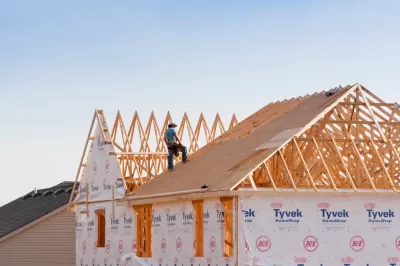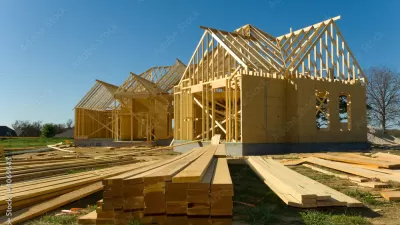The housing construction market is responding to strong demand with a glut of new single-family homes.

A January report by the National Association of Home Builders (NAHB) provides evidence of a new wave of single-family zoning in the United States as the home building industry overcame inflation worries, rising construction costs, and supply chain limitations to increase the number of housing starts to levels not seen since before the recession.
An article by Robert Dietz, published by NAHB, reveals details of the report, which shows large numbers of housing starts in both single-family housing and multi-family housing. Only homes with two to four units, a prominent typology of the missing middle targeted by zoning reforms in cities all over the country, declined.
Dietz summarizes the study:
Home building ended 2021 with strong annual gains as demand accelerated in the wake of the pandemic. These annual gains were realized despite supply-chain limitations for materials and ongoing access issues for labor and lots. Single-family starts ended 2021 with a 13.4% increase for a total of 1.123 million starts. Multifamily 5+ unit construction ended the year with a 22.1% gain, for a total of 460,100 starts. A component of the missing middle, 2 to 4 unit construction showed a decline for 2021, a 2.8% drop.
A news article picking up the story, written by Carlos Waters for CNBC, notes that last year's 1.123 million single-family housing starts is the highest number since 2006. Waters uses the new data as an opportunity to build the case against strict, exclusionary zoning rules, citing Ben Ross, author of Dead End: Suburban Sprawl and the Rebirth of American Urbanism to help make the case.
Waters's conclusion: "Today’s homebuyers are paying for past sprawl by drawing on credit to finance their lifestyles. Meanwhile, the cost of public infrastructure maintenance is weighing on depopulating towns across the country."
The NAHB's data about single-family starts echoes a recent report from Redfin that estimates one-third of all homes available for sale are new.
FULL STORY: Housing Starts End 2021 with Annual Gains

Planetizen Federal Action Tracker
A weekly monitor of how Trump’s orders and actions are impacting planners and planning in America.

Congressman Proposes Bill to Rename DC Metro “Trump Train”
The Make Autorail Great Again Act would withhold federal funding to the system until the Washington Metropolitan Area Transit Authority (WMATA), rebrands as the Washington Metropolitan Authority for Greater Access (WMAGA).

The Simple Legislative Tool Transforming Vacant Downtowns
In California, Michigan and Georgia, an easy win is bringing dollars — and delight — back to city centers.

The States Losing Rural Delivery Rooms at an Alarming Pace
In some states, as few as 9% of rural hospitals still deliver babies. As a result, rising pre-term births, no adequate pre-term care and "harrowing" close calls are a growing reality.

The Small South Asian Republic Going all in on EVs
Thanks to one simple policy change less than five years ago, 65% of new cars in this Himalayan country are now electric.

DC Backpedals on Bike Lane Protection, Swaps Barriers for Paint
Citing aesthetic concerns, the city is removing the concrete barriers and flexposts that once separated Arizona Avenue cyclists from motor vehicles.
Urban Design for Planners 1: Software Tools
This six-course series explores essential urban design concepts using open source software and equips planners with the tools they need to participate fully in the urban design process.
Planning for Universal Design
Learn the tools for implementing Universal Design in planning regulations.
Smith Gee Studio
City of Charlotte
City of Camden Redevelopment Agency
City of Astoria
Transportation Research & Education Center (TREC) at Portland State University
US High Speed Rail Association
City of Camden Redevelopment Agency
Municipality of Princeton (NJ)





























